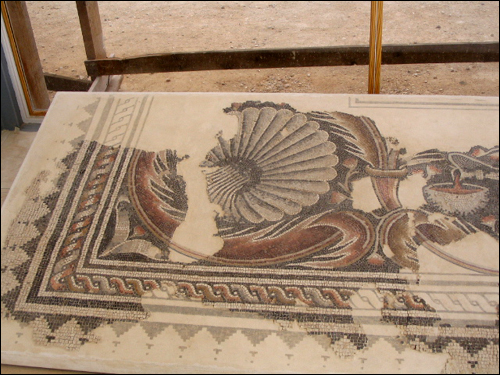
Scroll down the list for other articles.

Mosaic museum opens in the West Bankby ETGAR LEFKOVITS The official dedication of the NIS 10 million museum, which displays mosaics from the West Bank and Gaza, coincided with US President Barack Obama's long-touted Middle East speech in Cairo in which he reached out to the Muslim world. Israeli officials at the event said that the timing of the
museum's inauguration, which was attended by Knesset Speaker Reuven Rivlin
of the ruling Likud Party and Tourism Minister Stas Misezhnikov of Israel
Beitenu, as well as Christian religious leaders, was coincidental, but
also served as a timely reminder of Israel's historical connection to
the area.
9th century Byzantine mosaic - photo 2008 by Y. Tommer The tourism minister voiced the hope that the site, which is open free of charge to the public daily, except Saturday, will become a major tourist attraction for Christian visitors to the Holy Land. "I believe that this site will become a center of pilgrimage for millions of Christians from around the world," Misezhnikov said. The site, known as the Inn of the Good Samaritan, received its name in the Byzantine period when it was identified with the inn mentioned in the Parable of the Good Samaritan in the New Testament. The site lies on the upper end of the ascent on the main road from Jericho to Jerusalem, which pilgrims followed when traveling from the Galilee and Transjordan to the Holy City. Over the last decade, archeologists have uncovered remains dating back to the Second Temple period at the site. During the Byzantine period, the site was revived as a way station for Christian pilgrims, and an inn was constructed that included a large church, a cistern, residential quarters, and a fortress to protect pilgrims from brigands. In the Crusader period, with the expansion of pilgrimage to Jericho and especially to baptismal sites on the Jordan River, the inn was renovated and a fortress erected above it to guard the road to Jerusalem. The structure housing the museum was built in the Ottoman period as a guard post, which remained in use until recently. The mosaics on display at the museum were discovered in the West Bank and Gaza and belong to Jewish and Samaritan synagogues - including a mosaic from a Gaza synagogue - as well as churches. The melange of mosaics at the museum - which are divided into an indoor and outdoor display - was inspired by the Parable of the Good Samaritan which features members of three faiths: Jews, Jesus and a Samaritan who performs a merciful deed. Source: The Jerusalem Post Photograph from OhmyNews International
|
All
content is copyright of © Mosaic Matters and its contributors.
All rights reserved
Mosaic
Matters is:
Editor: Paul Bentley
Web Manager/Designer: Andy Mitchell
